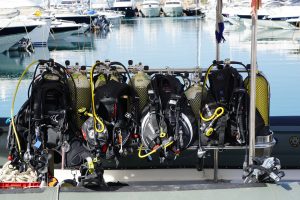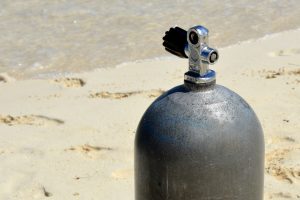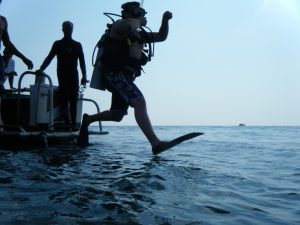Fluffy Rabbits? Yeah 😀 exactly!
When you go diving one of the most important things that you need to do is the so called “buddy check”. In recreational diving you never go underwater alone, whether you already have your favourite dive buddy with you or not, a diving center will not allow you to go underwater without a buddy. The buddy system is a reliable method to watch out for one another underwater. If you go to a diving center alone, no worries: they will introduce you to another diver who’s more or less at your level or they will pair you up with one of their Divemasters or Instructors. This way if anything happens underwater you have somebody to cover your back! Clever, right?
There are several exercises that you can practice with your buddy before jumping in the water, including all the communication signs, but probably the most important one that can really prevent major issues underwater is the buddy check that you do right before you start your dive. Actually, I’d like to count it as the very beginning of your dive.

So, what do you need to check?
Big White Rabbits Are Fluffy is a mnemonic to remember the acronym BWRAF.
B stands for BCD
BCD or Buoyancy Control Device is the jacket that has that special tank strap to carry your tank as if it was your backpack. The most important feature of the BCD is that it has an internal bladder that you can inflate or deflate according to your needs. E.g. if you need to stay on the surface before or after a dive you might want to inflate the bladder to be positively buoyant and float.
During the buddy check you need to push the inflator button and verify that the jacket inflates. Then push the deflating button and check that the jacket loses some air. Another good habit is to press and hold the deflating button while blowing air with your mouth into the low pressure hose (you can find a mouthpiece close to the two buttons). This is helpful in case the inflator button gets stuck for whichever reason.
To release the air in the jacket this time pull the tethers of the quick dump valves. Modern BCDs have one on the right shoulder and one on the lower back. With some BCDs you need to pull down the whole low pressure hose. These valves are also used to automatically release some air in case you accidentally push the LPI button for too long. You wouldn’t want your jacket to burst, right? 😉
W stands for Weights
The common way to wear weights is using a weight belt. This is usually the way they teach you to dive: you have some blocks of lead all around your waist and a release buckle. Check that both your and your buddy’s belt can be opened using the right hand. This is a common standard and even if you are left-handed it’s important that the buckle is released holding the belt with your right hand and pulling to the right. In case of emergency when you need to damp your or your buddy’s weights, there’s no time to figure out that the belt was not donned according to the standards.
Another way to wear weights is using the integrated weight system in the BCD. These are pockets that come with a zip or a velcro on both sides of the BCD and resting on your hips. The two pockets must be secured to their mechanism (they should not come out with a gentle pull), closed and balanced. In both cases -belt and BCD integrated weight system- the weights need to be symmetrically distributed and comfortable to wear. Having a block of lead on your belt right in the middle of your back is not a very good idea because that’s a sensitive part of your body and the tank will rest exactly on top of it. You will very likely have a big black bruise if you do it!
Make sure that the blocks of lead are equally distributed on both sides of your or your buddy’s waist. Remember that some BCDs have trim pockets. If you or your buddy use them to carry extra weight, make sure that these pockets are closed.

R stands for Releases
Releases come in all shapes and sizes in different BCDs. However the most important ones to check are the chest buckle, the two shoulder buckles, and the waist buckle, including the velcro waist band below it. If you use both hands to check your buddy start under his/her chin to check the chest buckle, then proceed to the shoulders and complete with the waist. You need to check that all the buckles are closed and tightened enough to secure the jacket on your buddy’s torso but not too much. Your buddy needs to breathe! 🙂 Don’t forget to ask your buddy to turn around so that you can check the tank strap around the tank that has to be closed tightly. With both your hands hold the first stage and the bottom of the tank and shake it a little bit up and down to check that it doesn’t move.
A stands for Air
You want to breathe underwater? Well, then you’d better check that you have air! Whether you or your buddy are using normal air (with 21% oxygen) or Nitrox (usually up to 40% oxygen – don’t use it if you’re not certified!) the buddy check is the same: verify that the tank is open. Some diving centers will tell you that you need to open it completely and then close it by a quarter-turn. Some others will tell you that it’s no longer recommended. Just follow their instructions. With one hand hold your buddy’s manometer and with the other his regulator. Purge it (no free flow? Then ok!) while you smell the air coming out. It smells good?
Then proceed to take a couple of breaths from the regulator while you look at the manometer: the gauge should stay in place and you should be able to breathe comfortably. Repeat with his/her octopus and then replace it in the triangle formed by your buddy’s chin and the base of the ribs. It needs to be visible (usually it’s yellow for this reason) and secured enough to stay in place during a dive but also easily releasable in case of emergency. Check the hoses for signs of damage.

F stands for Final OK
Check that your buddy has everything else: mask, fins and all the other accessories (camera, hook, torch light, knife…etc.) depending on the type of dive that you’re going to do. Also all the equipment needs to be streamlined and secured: you don’t want to lose parts of it and you don’t want to damage the marine life. Check the hooks, pocket zips and any protruding part that you might want to secure better. Give your buddy an OK sign and enjoy your dive!
If you’re diving with a new buddy, the buddy check will help you familiarise with his/her equipment that might be slightly different from yours. In case you run out of air can you easily see and grab his/her octopus? Is your buddy nervous during the buddy check? Are you comfortable with the idea that if something happens to you while underwater you can trust him/her with your life?
I can’t stress enough the importance of the buddy check before every dive. Please don’t take it for granted that your equipment will work fine just because it has so far! Whether you’re diving with your usual buddy or with someone new, take your time and go through the 5 steps of the buddy check: it might save your and your buddy’s life!

Here are some more mnemonics for BWRAF:
Begin With Review And Friend
Beans With Rice And Fish
Because We Really Are Friends
Bunnies Will Run Away Fast
Breathing Water Really Ain’t Fun
Bubbles With Real Awesome Fun
Do you have some more? I’d like to hear them 🙂

2 Responses
My OWD instructor always used “Big Waves Really Are Fun.”
That is a new one! 🙂 Thank you, Laura!